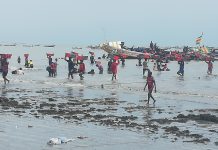Abdoulai G. Dibba
The Food and Agriculture Organisation (FAO) has provided the sum of 20.4 million Dalasi to the The Gambia to support the  Ministry of Agriculture to conduct a Technical Cooperation Programme (TCP) to control the devastating Whitefly infestation in the country.
Ministry of Agriculture to conduct a Technical Cooperation Programme (TCP) to control the devastating Whitefly infestation in the country.
This was disclosed by Madame Mariatou Fall, who was delivering a statement on behalf of the FAO Country Representative at a workshop held in collaboration with the Plant Protection Services under the Ministry of Agriculture on Wednesday 21 September, 2016 at the Kairaba Beach Hotel.
Madame Mariatou Njie said the Whitefly which originated from Central America and the Caribbean is now widespread in West Africa and devastating fruit trees, vegetables and ornamental plants in the Gambia thus resulting in economic loss to farmers and communities. She added that this situation is threatening to the livelihood and food security of communities and has great economic significance.
It is for this reason, said Madame Njie, that Ministry of Agriculture and FAO designed a Technical Cooperation Programme (TCP) to control this devastating insect pest.
Madame Njie told the participants that the objective of the TCP is to control this Whitefly in a sustainable and environment-friendly manner, by employing integrated pest management approaches and building the capacity of the Plant Protection Services in terms of human resource capacity and equipment to control the Whitefly.
The FAO official said the capacity of national experts and farmers will be strengthened and the resilience of farmers enhanced and their livelihoods restored. She said the project fits in well with the FAO’s first strategic objective which is to help eliminate hunger, food insecurity and malnutrition, and its second Strategic Objective: Making agriculture more productive and sustainable.
In delivering his opening statement, the Deputy Minister of Agriculture Sheriffo Bojang said the spiraling Whitefly was first observed in Florida by Russell in 1957 and that in 1992, it was discovered in continental Africa with a severe outbreak reported in Nigeria, thence to other West African countries, including The Gambia.
Deputy Minister Bojang said PPS has observed these pests on numerous fruit trees, shade trees, ornamentals and vegetables everywhere in the country, particularly in the West Coast and North Bank regions that this is why the TCP will be targeting these two highly infested regions.
Up till now, he said, the population and infestation levels of these flies continue to increase tremendously and that the pests are found to be causing a lot of damages on mangoes, papaya, guava, citrus, plum, sour sop, noni, shade trees and ornamental plants.
Deputy Minister Bojang revealed that a significant negative economic impact of up to 100% yield losses has been realised in some instances with papaya and citrus fruits.
Plant Protection Services, Department of Agriculture, he said, is the hub for their plant health issues and that the plant health issues are of universal concern as enshrined in the International Plant Protection Convention (IPPC) and in the new Plant Health Protection Bill 2014 of the Ministry of Agriculture.
“To conclude my speech, I would, on behalf of the Honourable Minister and the Government of this Country likes to earnestly thank FAO through its able Representative Madam Papetua Katepa Kalala and team for joining hands with us in the fight against the white flies,” he said.
Speaking earlier in his welcoming statement, Falalo Touray, the Director General of Agriculture, said the magnitude of crop loss and destruction to landscape and ornamental plants as a result of the whitefly infestation in the West Coast and North Bank regions is reaching significant proportions.
More importantly, he noted, is the fact that there is also a high risk of the insect pest spreading to new locations in The Gambia and to neighbouring countries if preventive measures are not swiftly put in place because the Whitefly has no border.
He concluded that failing to address this infestation in the North Bank may have an adverse effect on Upper River and the West Coast.




















